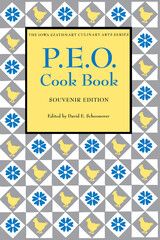5 books about Schoonover, David E.

The Khwan Niamut
Or, Nawab'S Domestic Cookery
David E. Schoonover
University of Iowa Press, 1992
This appealing little cookbook, published in Calcutta in 1839 with the weighty subtitle “Being a Selection of the Best Approved Recipes, of the Most Flavoured and Savoury Dishes, from the Kitchen of Nawab Qasim Uli Khan, Buhadur Qâum Jung, from the original Persian,” gave colonial Europeans a way to enjoy royal feasts in their own homes.The Khwan Niamut is an entertaining way for today's adventurous cooks to explore Asian dishes in their own homes.
Translated as “Table of Riches,” The Khwan Niamut offers a collection of tempting recipes from the lavish household of Qasim Uli Khan which did indeed allow transplanted colonials to dine like shahs. All the refinements of Persian cookery—from hearty pilaus and curries and kababs to delicate almond comfits and such mandatory accessories as mango and lemon pickles—are served up in the pages of this facsimile edition.
The Khwan Niamut also includes many traditional ways of preserving meats, eggs, fruits, juices, and dairy products, growing mushrooms—“If the water wherein mushrooms have been steeped or washed be poured upon an old bed…there will speedily arise great numbers”—perfuming linen with rose leaves, cloves and mace, and preparing “a fine strong tincture of coffee.” A lengthy appendix caters to British taste buds, allowing homesick colonials to prepare less exotic but more familiar dishes such as mutton hash, veal broth, eel pie, lemon custard, and ginger beer.
To satisfy today's tastes and methods, David Schoonover has updated many festive Persian dishes as a major part of this introduction, which places this cookbook in the context of culinary history. More experienced cooks will enjoy the full range of recipes inThe Khwan Niamutusing the tables that translate such measures as chuttacks, mashas, and seers into modern equivalents. Everyone seeking to broaden their culinary repertoire will delight in the recipes and history of The Khwan Niamut.
[more]

Ladie Borlase's Receiptes Booke
David E. Schoonover
University of Iowa Press, 1998
Ladie Borlaise's Receiptes Booke, an English manorial and culinary manuscript, has been in existence for at least 333 years. This manuscript, bearing dates from 1665 to 1822, provides a unique compendium of culinary history that opens a window to the aristocratic, social, agricultural, horticultural, economic, and medicinal aspects of English country life.
The Borlase manuscript is a kind of miscellany. Included are recipes not only for all kinds of foods but also for distilled waters, remedies, dyes, soaps, and perfumes. A housewife of that period was responsible for keeping her family healthy and her house clean and sweet smelling, and so the manuscript features directions for preparing medicinal “oyles,” waters, “glysters,” powders, “ballsoms,”a “true Majistery,” and a julep, with healing powers for a number of ailments from apoplexy and gout to cancer and the plague.
The cookery recipes concentrate almost entirely on sweets and meats with only a few mentions of vegetables. More than half of the recipes included in this manuscript are for sweets. This was important as sugar was entering Britain in greater quantities and because people believed in sugar's supposed health benefits. Several recipes for preserved fruits reflect a changing diet and appetite among the British as the availability of fruits and vegetables increased in both quantity and variety.
David Schoonover's informative introduction places the Borlase manuscript in its historical context with special attention to the economic and social changes of the sixteenth and seventeenth centuries, which brought about a new emphasis on housewifery and the management of households. He also provides a brief summary of the Borlase family history—born in 1621, Alice Bankes, Lady Borlase, died in 1683 at the age of sixty-two years—and a description of their home at Bockmer Manor at Medmenham, Buckinghamshire.
[more]

The Ladies' Etiquette Handbook
The Importance of Being Refined in the 1880s
David E. Schoonover
University of Iowa Press, 2001
Prior to the late nineteenth century, most Americans viewed dining as a utilitarian duty characterized by common “meat and potato” dishes and complemented by little, if any, polite conversation. With the boom in industrialism and the sudden growth of the middle class in the 1880s, America's interest in social etiquette rose dramatically.
Consisting of two separate publications—The Ladies' Handbook and Household Assistant(1886) and Short Hints on Social Etiquette (1887)—The Ladies' Etiquette Handbook can be read as a testament to the growing division between social classes and, at the same time, as a reflection of the middle class' overwhelming desire to cross social lines through the graces of fine etiquette.
Written by a Methodist women's church group in Manchester, New Hampshire, The Ladies' Handbook and Household Assistant provides advice on subjects such as church etiquette and the proper handling of cutlery as well as recipes for the socially active household. Short Hints on Social Etiquette, published as a promotional piece by a Philadelphia soap manufacturer—including descriptions of lavish meals, advice on proper word pronunciation, and illustrations of tasteful calling cards—strives to bring “aristocratic” values into the “republican” home.
The foreword by Kenneth Cmiel, professor of history at the University of Iowa, provides an overview of the historic and social trends leading up to the publication of both handbooks and traces the creation and ultimate development of modern social etiquette.
[more]

P.E.O. Cookbook
Souvenir Edition
David E. Schoonover
University of Iowa Press, 1992
In 1908 members of Chapter "M" of the P.E.O. in Knoxville, Iowa, compiled the P.E.O. Cook Book: Souvenir Edition, complete with 575 of the organization's best recipes, fully tested, and 24 original photographs of the Knoxville community. Now this charming cookbook, long out of print, is made available again in a facsimile edition as part of the Iowa Szathmáry Culinary Arts Series.
The recipes in this remarkable cookbook take the modern cook back to a time when the ability to prepare attractive, delicious dishes with economy and innovation from a sometimes limited supply of ingredients was both a challenge and a major source of pride. The P.E.O. Cook Book reproduces the cream of the crop: unusual dishes such as Kebobbed Oysters, Oyster Short Cake ("If this is carefully made it is delicious"), Green Corn Balls, Tomatoes Stuffed with Eggs, Nice Candy, and the requisite P.E.O. Salad, in the club's colors of yellow and white. Club members present tasty renditions of familiar themes in breads, meats, soups, salads, condiments, and desserts and several dishes that are extraordinarily thrifty. Here are honest, forthright recipes that modern readers will thoroughly enjoy.
A familiar feature in many towns, the P.E.O. Sisterhood was founded in 1869 at Iowa Wesleyan College in Mt. Pleasant, Iowa. The meaning of the club's initials remains a closely guarded secret, but the P.E.O. now stands some 240,000 strong and is a worldwide philanthropic educational organization with projects on the international, national, state, and local levels.
[more]

To Set before the King
Katharina Schratt's Festive Recipes
Gertrud G. Champe
University of Iowa Press, 1996
READERS
Browse our collection.
PUBLISHERS
See BiblioVault's publisher services.
STUDENT SERVICES
Files for college accessibility offices.
UChicago Accessibility Resources
home | accessibility | search | about | contact us
BiblioVault ® 2001 - 2025
The University of Chicago Press









